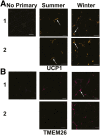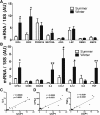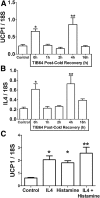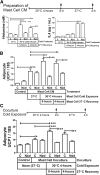Mast Cells Promote Seasonal White Adipose Beiging in Humans
- PMID: 28250021
- PMCID: PMC5399616
- DOI: 10.2337/db16-1057
Mast Cells Promote Seasonal White Adipose Beiging in Humans
Abstract
Human subcutaneous (SC) white adipose tissue (WAT) increases the expression of beige adipocyte genes in the winter. Studies in rodents suggest that a number of immune mediators are important in the beiging response. We studied the seasonal beiging response in SC WAT from lean humans. We measured the gene expression of various immune cell markers and performed multivariate analysis of the gene expression data to identify genes that predict UCP1. Interleukin (IL)-4 and, unexpectedly, the mast cell marker CPA3 predicted UCP1 gene expression. Therefore, we investigated the effects of mast cells on UCP1 induction by adipocytes. TIB64 mast cells responded to cold by releasing histamine and IL-4, and this medium stimulated UCP1 expression and lipolysis by 3T3-L1 adipocytes. Pharmacological block of mast cell degranulation potently inhibited histamine release by mast cells and inhibited adipocyte UCP1 mRNA induction by conditioned medium (CM). Consistently, the histamine receptor antagonist chlorpheniramine potently inhibited adipocyte UCP1 mRNA induction by mast cell CM. Together, these data show that mast cells sense colder temperatures, release factors that promote UCP1 expression, and are an important immune cell type in the beiging response of WAT.
© 2017 by the American Diabetes Association.
Figures






References
-
- Cannon B, Nedergaard J. Brown adipose tissue: function and physiological significance. Physiol Rev 2004;84:277–359 - PubMed
-
- Rothwell NJ, Stock MJ. A role for brown adipose tissue in diet-induced thermogenesis. Nature 1979;281:31–35 - PubMed
-
- Lowell BB, S-Susulic V, Hamann A, et al. . Development of obesity in transgenic mice after genetic ablation of brown adipose tissue. Nature 1993;366:740–742 - PubMed
-
- Virtanen KA, Lidell ME, Orava J, et al. . Functional brown adipose tissue in healthy adults. N Engl J Med 2009;360:1518–1525 - PubMed
Publication types
MeSH terms
Substances
Grants and funding
LinkOut - more resources
Full Text Sources
Other Literature Sources
Miscellaneous

